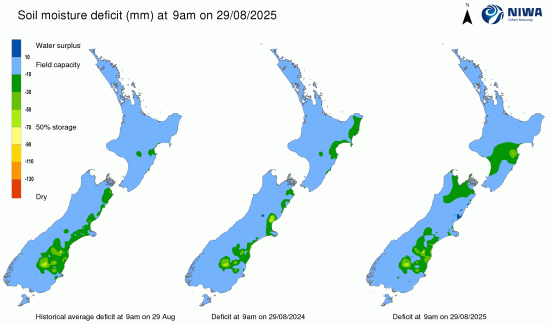Here's our summary of key economic events overnight that affect New Zealand, with news China and the US seem to have agreed some sort of deal although the details are still quite fuzzy. However a key part seem to be that the US will only get access to the rare earth minerals on a 180 day rolling basis. That means Beijing will retain key leverage over these negotiations as they develop.
From data out in the US, CPI inflation was recorded at 2.4% in May, up marginally from 2.3% in April but coming in lower than the +2.5% expected. Food prices however were up +2.9%, rents up +3.9% in this survey. The only reason the overall level was modest is that petrol prices fell -3.5% from a year ago.
Interestingly, US crude oil prices were near a one-year high a year ago at US$78/bbl. Today they are at US$67/bbl.But they have fallen steadily from there so after August it seems likely that US petrol prices will generate upward pressure on their CPI, just about at the time tariff-tax flow throughs start to bite. Could get "interesting" in about 90 days.
Meanwhile US mortgage applications jumped more than +12% last week from the prior weak three weeks. It is a pattern we have observed since September - three weeks of declines followed by a single week of recovery, usually because those holding off refinancing while waiting for rates to fall can't wait any longer. The benchmark 30 year fixed rate was unchanged last week at 6.93% plus points.
There was another US Treasury 10 year bond tender earlier today, and this one featured an outsized fall in demand. There were more than -10% less bids than at the prior equivalent event. The median yield achieved was 4.38% today, up from 4.28% at that prior equivalent event.
This is the first time we have seen a big fall-off in demand in these official tenders, so it will be worth keeping an eye on it going forward to see if this is a one-off, or the feared pullback in investor appetite for Trump-debt.
At the same time, the US Budget Statement for May showed a monthly deficit of -US$316 bln, only marginally less than the -US$346 bln for the same month a year ago. Higher tariff collections at the border are getting the credit, of US$23 bln in the month. That would mean the DOGE has had zero impact on the budget. They have booked a -US$2 tln deficit in the twelve months to May, and on track for more than that for their fiscal year to September. If the current Budget Bill passes with its tax cuts for the rich, and suspension of the debt ceiling, you can see why investors would want sharply higher risk premiums for holding US federal debt when the mismanagement is so rife.
In Canada, April building consents came in -6.6% below March levels to be -16% lower than year ago levels (which featured a strong April 2024 surge).
In China, May vehicle sales came in at almost 2.7 mln units in the month with almost half of them NEVs. That puts sales for the past year at a remarkable 32.7 mln, and more than double the level in the US (15.6 mln units in the past year). One key reason is the Beijing-backed trade-in incentives that are designed to support their manufacturing activity through the tariff-war and their drive to build and rely more on internal consumption. It seems to be working with this incentive in place, but can they wean themselves off it?
The UST 10yr yield is now at 4.42%, and down -5 bps from this time yesterday. The key 2-10 yield curve is still at +46 bps. Their 1-5 curve is now inverted by -7 bps. And their 3 mth-10yr curve still positive but now at +17 bps. The Australian 10 year bond yield starts today at 4.25% and down -2 bps from yesterday at this time. The China 10 year bond rate is holding at 1.69%. The NZ Government 10 year bond rate starts today at 4.63% and down -1 bp.
Wall Street was marking time in its Wednesday session of the S&P500 until 2pm (local time) when it started falling, now down -0.4% as sentiment suddenly turned against tech stocks. The Nasdaq turned before the S&P500 from small gains to a sudden -0.7% drop. European markets drifted about -0.2% on average in overnight trade. Tokyo ended yesterday up +0.5%, Hong Kong was up +0.8% and Shanghai ended up +0.5%. Singapore ended down -0.4%. The ASX200 was up a minor +0.1% in its Wednesday trade. The NZX50 ended up +0.3%.
The price of gold will start today at US$3,323/oz, and virtually unchanged from yesterday.
American oil prices are up +US$2 at just over US$67/bbl while the international Brent price is now just under US$69/bbl.
The Kiwi dollar is now just over 60.4 USc, basically holding from yesterday. Against the Aussie we are also holding at 92.7 AUc. Against the euro we are down -30 bps at 52.6 euro cents. That all means our TWI-5 starts today at under 68.3 and down about -10 bps from yesterday.
The bitcoin price starts today at US$109,115 and up +0.4% from yesterday. Volatility over the past 24 hours has remained low at just on +/-0.8%.
Daily exchange rates
Select chart tabs
The easiest place to stay up with event risk is by following our Economic Calendar here ».
15 Comments
I don't understand this paragraph ?
"........... Interestingly, US crude oil prices were near a one-year high a year ago at US$78/bbl. Today they are at US$67/bbl.But they have fallen steadily from there so after August it seems likely that US petrol prices will generate upward pressure on their CPI, just about at the time tariff-tax flow throughs start to bite. Could get "interesting" in about 90 days......."
They are suggesting that after August, the 2025 price will be higher than the same period in 2024, and therefore inflationary.
Yes ummh. ??? It says petrol prices are down. 78 to 67. And this will lead to inflation. - but how. It's down not up.
And how does August come into it. Driving season?
78 in Jun24, but fell steadily from there. August comes into it because Aug24 is when the price was falling, to something lower than 78. So by the time we compare Sep24 to Sep25, the suggestion is that it will be an increase.
They may have looked at oil price futures to anticipate what Sep25 will be.
Or maybe it was just a messy paragraph
Fox viewers will be celebrating a big beautiful deal with China.
I've tried to understand what they've achieved, but it just seems they've agreed to go back the way it was before Trump started fiddling albeit with tariffs in place.....? Not signed yet either, so it's more the suggestion of one.
Never fear Murray. Best you "stay calm and carry on" when he throws toys and firecrackers about.
Sure enough a bit later there is a deal.
It's just a method.
TACO!
But the media output is utter BS!
None of which will be any better than the deals the US already had. Meanwhile China has the world to itself, quickly becoming the safe bet.
If China had more more diplomatic with Hing Kong and was more accommodating with Taiwan, I'd say the rest of the world would be less fearful and more open to Chinese supremacy.
Why can't China see this?
From Tony Alexander's weekly newsletter
"The net proportion of people planning to go overseas has in fact risen to a record high for the five year duration of our survey to +17% from +10% last month."
Subsea water desal. without need for high pressure pumps.
"By operating at depth, our systems use the ocean’s natural pressure as a free energy source, eliminating the need for massive surface infrastructure or high-pressure pumps."
https://www.flocean.green/post/flocean-to-launch-the-first-commercial-s…
clever
Sound good but nothing is free. That depth would be kilometres off shore, (50+ kilometres for Aus) - factor in engineering requirement at 500m, extreme corrosion, power to sight, getting water back to shore and so on. Damn expensive water.
Just plant some trees.
If only there was some redundant offshore infrastructure complete with pipes to the shore that could be utilised. Desal is getting to less than $0.50/m3 - does Wellington do it that cheap?
I see Ikea are an investor so they have a foot in the tree planting camp and the subsea desal. camp.



We welcome your comments below. If you are not already registered, please register to comment.
Remember we welcome robust, respectful and insightful debate. We don't welcome abusive or defamatory comments and will de-register those repeatedly making such comments. Our current comment policy is here.